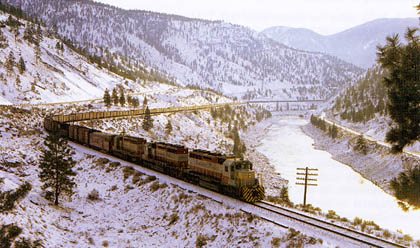 |
 |
|
|
|
|
|
Summer
2004

Canadian Pacific Railway Employee
Communications
Room 500 401-9th Ave S.W. Calgary AB T2P
4Z4
GM Versus
MLW
Jonathan Hanna

Testing mid-train,
robot-controlled SD40s along the Thompson River in 1967.
Despite the success of SD40s in
robot-controlled, mid-train tests, they were
plagued by traction and wear problems.
When General Motors (GM) first offered its new high-horsepower
mainline SD40 locomotive, 39 years ago, CPR lined up, in September 1965,
and ordered 32 of them. The powerful 3,000-h.p. locomotives
came out of GM's Canadian plant in London, Ontario, the following July
through December 1966. They were numbered 5500 to 5531. CPR freed up some
more capital in June 1966 and ordered 33 more. These arrived on the scene
in the first quarter of 1967. They were numbered 5532 to 5564.
There was traffic aplenty on the CPR from the mid-1960s to the
mid-1970s. CPR's mid-1960s trade-in
arrangement with Canada's major locomotive manufacturers got the railway
new power at a discount and reduced overall maintenance costs. But it didn't
enlarge the fleet. So CPR expected great things from the SD40s, its highest
horsepower diesel-electric locomotives yet. More powerful than
the 2,400-h.p. Trainmaster locomotives or the equally powerful,
one-of-a-kind, "Empress of Agincourt".
At the end of 1967, CPR introduced mid-train power.
Robot-controlled locomotives, strategically placed in the
middle of a train, made it possible to pull longer, heavier trains with
less stress. It used its new SD40 locomotives, decked out in the
tuscan-and-gray livery of the day.
As great as these locomotives looked, and as successful as they were in
pioneer Robot-controlled, mid-train locomotive
tests, there were problems. The SD40s had wheel-slippage woes,
excessive assembly wear, and turbocharger failures. So CPR did an about
face and its next order for high-horsepower locomotives went
to the Montreal Locomotive Works, Canada's other large locomotive
manufacturer. CPR ordered the 3,000-h.p. and
3,600-h.p. models, with their highly touted
high-adhesion trucks. However, by 1972, the underperformance
of the MLW units, and the heavy maintenance required to keep them in
service, drove CPR to make an absolute and unequivocal return to GM's
main-line product - the SD40-2. By this time, GM had solved
the traction and wear problems. SD40-2 locomotives came with a modular
electronic control system and high-traction trucks.
CPR acquired 15 more SD40 locomotives, second-hand, in the
mid-1980s, from the Quebec, North Shore and Labrador Railway
(QNS&L).
When CPR acquired a 100 percent stake in the Soo Line, in 1990, the US road
added its own contingent of 33 SD40s to CPR's fleet. One of these, and
ex-Burlington Northern SD40B, stood out from the pack. No.
6450 had no cab at all. It was a booster, or B-unit.
The B-unit, the QNS&L locomotives, all 65 original CPR
SD40 locomotives, and all but one of the Soo Line SD40s - No. 738 - are now
retired. CPR's very first SD40 locomotive - No. 5500 - is being donated to
the Revelstoke Railway Museum in British Columbia.
| |
Vital
Statistics
|
Numbers
|
5500-5564
|
Class
|
DRF-30a /
DRF-30b
|
Builder
|
General Motors Diesel
Division (London Ontario)
|
Outshopped
|
1966-1967
|
Builder's
Model
|
SD40
|
Horsepower
|
3,000
|
Cylinders
|
16
|
Axles
|
6
|
Maximum
speed
|
65 mph
(105 kph)
|
Length
|
65 ft. 8 in.
(20 m)
|
Weight
|
393,000 lbs.
(178,265 kg)
|
Purchase
price
|
$336,864. 5500-5531
$339,768 5532-5564
|
This Momentum
article is copyright 2004 by Canadian Pacific Railway and is reprinted
here with their permission. All photographs, logos, and trademarks are
the property of the Canadian Pacific Railway Company.
|
|
|
|